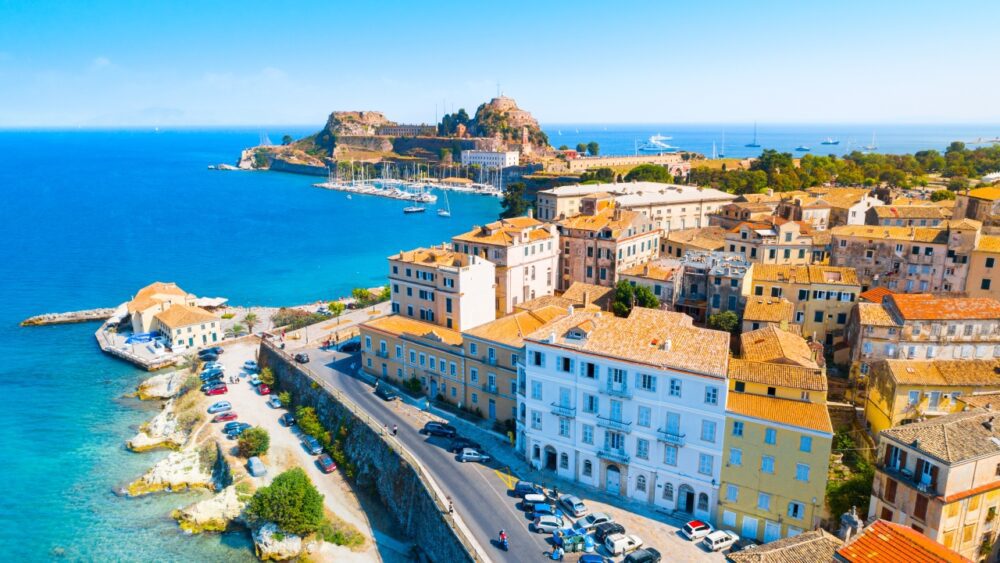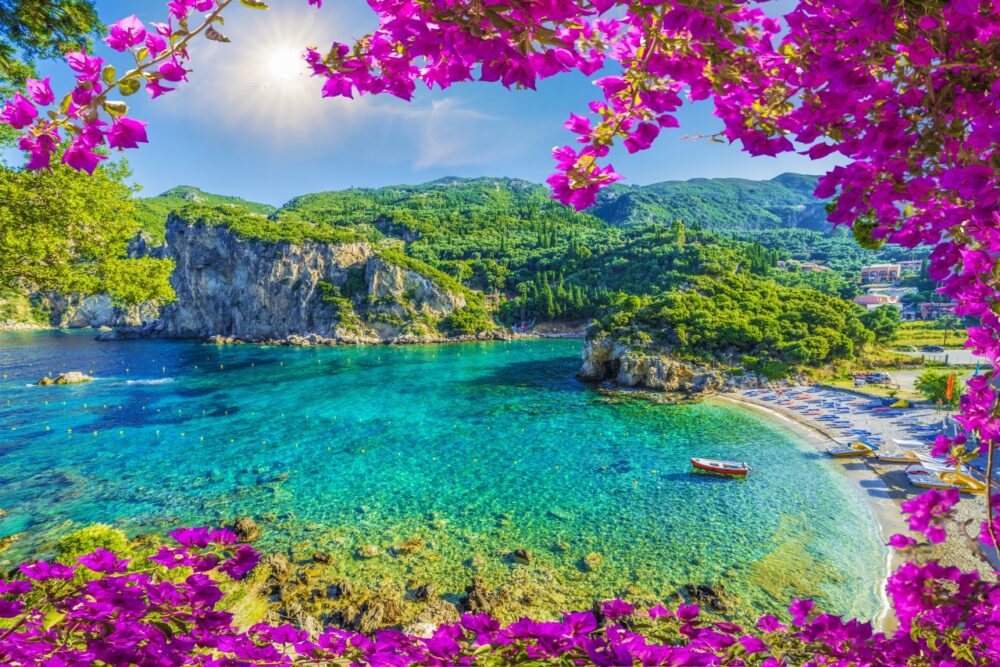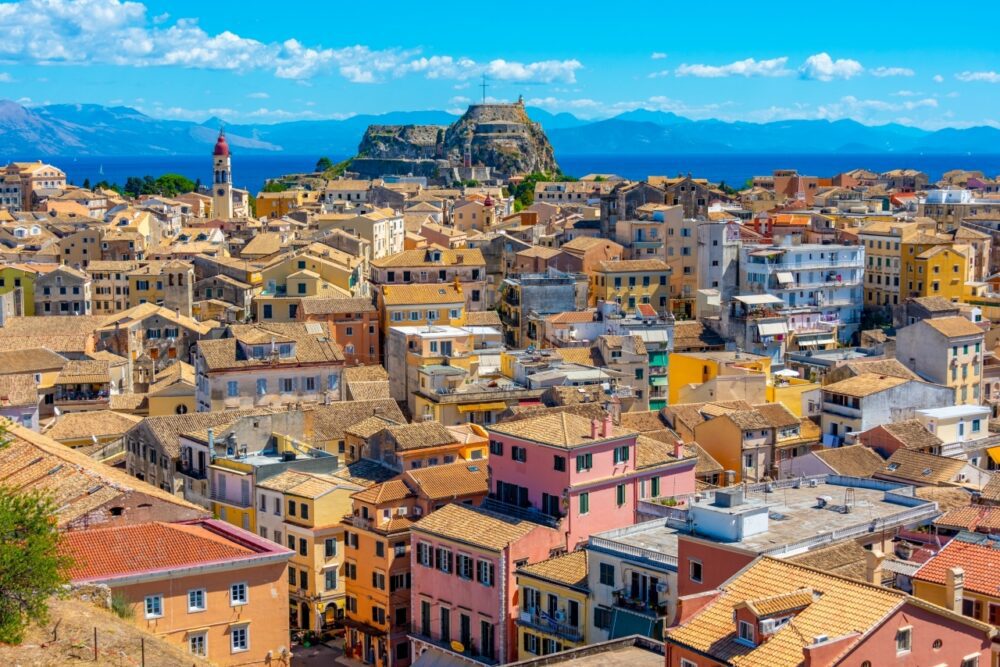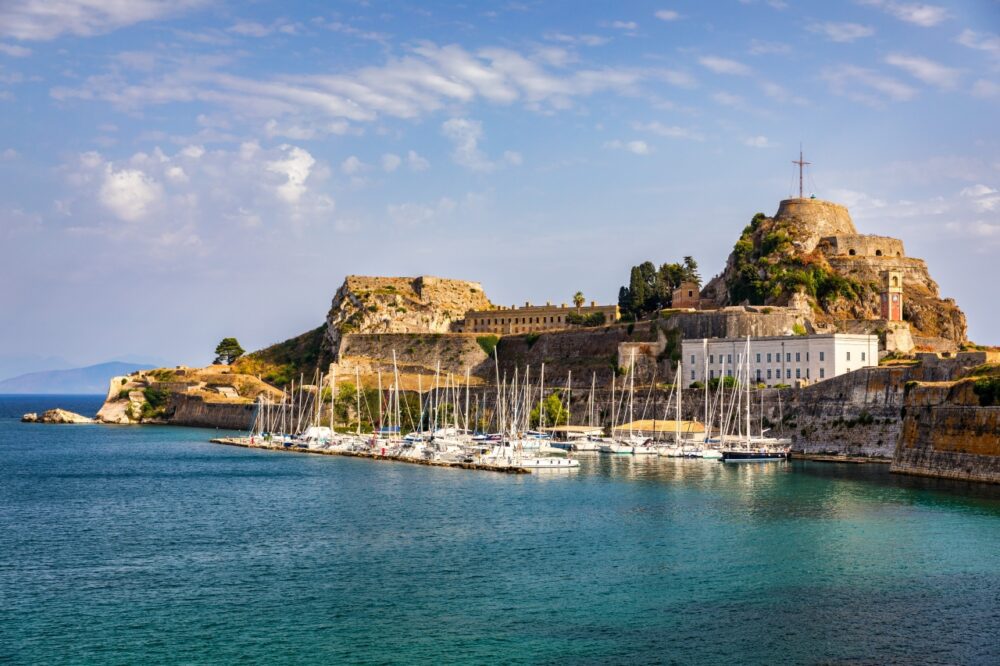
Is Corfu worth visiting? Without a doubt! The first time I set foot on this lush Greek island, I was struck by its unique blend of natural beauty, Venetian charm, and laid-back vibe. From exploring the charming streets of Corfu Town to lounging on its golden beaches, every moment felt like a postcard come to life.
Located in the Ionian Sea, Corfu is one of Greece’s most enchanting islands. Known for its vibrant history and stunning landscapes, it offers a mix of cultural treasures and tranquil escapes. The Old Town, a UNESCO World Heritage Site, is packed with cobbled streets, historic fortresses, and charming cafés, while the island’s coastline boasts crystal-clear waters and secluded coves. Whether you’re diving into Greek mythology at Paleokastritsa or enjoying Corfiot cuisine at a seaside taverna, Corfu offers something for every traveller. But is Corfu worth visiting for you?
In this blog post, we’ll explore the top 10 reasons why Corfu should be on your travel list, from its iconic landmarks to its serene beaches. Plus, we’ll share practical travel tips to help you make the most of your visit. Keep reading to find out why Corfu is a destination that truly has it all.
Table of Contents
Pros – Reasons You Should Visit Corfu
1. A Stunning Island with Breathtaking Scenery

Corfu is one of the most beautiful Greek islands, offering a mix of dramatic coastline, lush green hills, and crystal-clear waters. Unlike the dry, rocky landscapes of some other Greek islands, Corfu is covered in olive groves, cypress trees, and wildflowers, giving it a rich, verdant appearance. Whether you’re exploring its rugged cliffs, hidden coves, or scenic mountain villages, the island’s natural beauty is impossible to ignore.
One of my favourite spots was Paleokastritsa, a stunning coastal area with turquoise bays surrounded by steep, forested hills. The view from the Monastery of the Virgin Mary, perched high above the sea, was unforgettable. I also took a boat tour to some of the nearby caves, where the water was so clear that I could see fish swimming beneath the surface. Further south, the Canal d’Amour in Sidari, a unique rock formation shaped by the sea, was another highlight. Legend has it that couples who swim through the canal will stay together forever, though I was more focused on admiring the striking cliffs and the brilliant blue water.
2. A Rich History with a Blend of Cultural Influences

Corfu has a fascinating history shaped by Venetian, French, and British rule, giving it a unique cultural identity that sets it apart from other Greek islands. This blend of influences is reflected in everything from the island’s architecture to its cuisine, making it an exciting destination for history lovers. The island has been a strategic stronghold for centuries, and its well-preserved fortresses, grand mansions, and cobbled streets tell the story of its past.
The highlight of Corfu’s history is its Old Town, a UNESCO World Heritage Site that feels more like an Italian city than a Greek one. Walking through its narrow alleys, I passed elegant Venetian buildings, French-style arcades, and hidden courtyards filled with cafés. The Old and New Fortresses offer spectacular views over the sea and the town, and I spent hours wandering through their ancient stone tunnels and battlements. One of the most unique historical sites was Achilleion Palace, a grand neoclassical mansion built by Empress Elisabeth of Austria. The palace, filled with statues and paintings inspired by Greek mythology, provided a glimpse into the extravagant lifestyles of European royalty.
3. Beautiful Beaches with Crystal-Clear Waters

Corfu is home to some of the best beaches in Greece, with a variety of options ranging from long sandy shores to secluded rocky coves. The island’s coastline is diverse, meaning you can find lively beaches with water sports and beach bars or quiet, hidden spots perfect for relaxation. The Ionian Sea surrounding Corfu is known for its stunning shades of blue, and the clarity of the water makes it ideal for swimming and snorkelling.
One of my favourite beaches was Glyfada, a long stretch of golden sand backed by green hills, where the shallow waters made it perfect for a relaxing swim. For something more secluded, I headed to Porto Timoni, a breathtaking double beach that can only be reached by boat or a steep hiking trail. The effort to get there was rewarded with an incredible view of two turquoise bays separated by a narrow strip of sand. Another highlight was Issos Beach, known for its rolling sand dunes and incredible sunsets. Sitting on the warm sand, watching the sun dip below the horizon, was one of the most peaceful moments of my trip.
4. Delicious Greek Food with Local Specialities
Greek food is famous worldwide, and Corfu’s cuisine has its own unique flavours, influenced by the island’s Venetian past. Traditional Greek dishes like souvlaki, tzatziki, and moussaka are widely available, but Corfu also has a range of local specialities that you won’t find elsewhere. The island’s fertile land and proximity to the sea mean that fresh ingredients are at the heart of every meal, whether it’s just-caught seafood, sun-ripened vegetables, or fragrant herbs.
One of the best dishes I tried was pastitsada, a Corfiot speciality of slow-cooked beef or chicken in a rich tomato and spice sauce, served over thick pasta. The flavours were deep and comforting, with hints of cinnamon and cloves giving it a unique twist. Another must-try was bourdeto, a spicy fish stew made with fresh red scorpionfish and a generous amount of paprika. I had this dish at a small seaside taverna in Benitses, where the fish had been caught that morning. For dessert, I tried koumquat liqueur, a sweet, citrusy drink made from the small orange fruits that grow on the island. It was the perfect way to end a meal while watching the sunset over the sea.
5. A Welcoming Atmosphere and Friendly Locals
Greek hospitality is legendary, and Corfu is no exception. The locals are warm, welcoming, and always happy to share stories about their island or recommend their favourite hidden spots. Whether you’re staying in a hotel, eating at a taverna, or simply asking for directions, you’ll likely be met with kindness and a genuine willingness to help.
One evening, I found myself in a small family-run taverna in a quiet village outside Corfu Town. The owner, an elderly Greek man, took the time to explain the menu in detail, suggesting his grandmother’s recipe for stuffed peppers and a locally made red wine. As I ate, he returned with a complimentary plate of homemade baklava and sat down for a chat about life on the island. This kind of hospitality was something I encountered throughout my stay, making my experience in Corfu feel incredibly personal and welcoming.
6. Plenty of Outdoor Activities and Adventures
Beyond its beaches, Corfu is a fantastic destination for those who love outdoor activities. The island’s mountainous terrain, dense forests, and scenic coastline provide countless opportunities for hiking, cycling, and water sports. Whether you’re an experienced adventurer or just looking for a bit of gentle exploration, there’s something for everyone.
I decided to hike up Mount Pantokrator, the highest point on the island, and was rewarded with breathtaking views stretching across the Ionian Sea to Albania. The trail wound through olive groves and tiny mountain villages where time seemed to stand still. Another great activity was kayaking along the coastline, exploring hidden caves and untouched beaches that can only be reached by sea. For those looking for a more relaxed adventure, boat trips around the island offer a fantastic way to see Corfu’s dramatic cliffs and secret coves from the water.
7. A Perfect Mix of Relaxation and Lively Atmosphere
One of the best things about Corfu is that it caters to all types of travellers. Whether you want a peaceful retreat surrounded by nature or a vibrant holiday with nightlife and entertainment, the island offers a perfect balance. The laid-back beach towns and remote mountain villages provide plenty of opportunities for relaxation, while Corfu Town and the more touristy areas offer lively bars, traditional Greek music, and energetic summer festivals.
I spent one night in Kassiopi, a charming fishing village that transforms into a lively hub in the evenings. The harbour was lined with tavernas and bars, with live Greek music playing as people danced on the streets. The atmosphere was infectious, yet it never felt overcrowded or overwhelming. On the other hand, my time in Pelekas, a quiet hilltop village, was all about slow, lazy afternoons, watching the sun set over the sea with a glass of wine. Corfu’s ability to offer both vibrant and peaceful experiences makes it an ideal destination, whether you’re looking for adventure, culture, or pure relaxation.
Cons – Things to Consider When Visiting Corfu
1. The Island Gets Very Crowded in Peak Season
Corfu is one of Greece’s most popular islands, attracting thousands of visitors each summer. While the island’s size helps spread out the crowds, the main tourist areas—especially Corfu Town, Paleokastritsa, and Sidari—can become extremely busy between June and August. Cruise ships also bring large groups of tourists, flooding the narrow streets of the Old Town and making it difficult to explore at a relaxed pace. Popular beaches can feel overcrowded, with sun loungers packed tightly together and limited space to enjoy the sand and sea.
I visited Corfu in late July, and by midday, some of the island’s most famous spots felt overwhelming. In Corfu Town, I found myself stuck behind slow-moving tour groups, struggling to take in the beauty of the historic streets without constantly weaving through crowds. At Paleokastritsa, one of the most picturesque coastal areas, finding a quiet spot on the beach was nearly impossible, with people crammed into every available patch of sand. Even getting a table at a good taverna required booking in advance. If you prefer a quieter experience, visiting in the shoulder seasons—May, early June, or September—is a much better option. The weather is still warm, but the island feels far more peaceful, allowing you to truly appreciate its charm.
2. The Roads Can Be Dangerous and Driving is Stressful
Corfu’s scenic landscapes and mountainous terrain make driving one of the best ways to explore the island, but it’s not without its challenges. Many of the roads are narrow, winding, and poorly maintained, with sharp bends and steep drops that require extra caution. In rural areas, road signs can be limited or confusing, and some roads suddenly turn from asphalt to dirt tracks. Additionally, Greek driving habits can be unpredictable, with local drivers often overtaking on blind corners or ignoring speed limits. In summer, traffic increases significantly, especially around Corfu Town, where navigating through the chaotic streets can be frustrating.
I rented a car to explore the island, and while it gave me the freedom to visit hidden beaches and mountain villages, it wasn’t always a relaxing experience. Some of the mountain roads were so narrow that passing an oncoming car required inching towards the edge of a steep drop, which was nerve-wracking to say the least. In busy areas, parking was another challenge. Finding a space in Corfu Town was almost impossible without circling the streets multiple times. Even in smaller villages, car parks filled up quickly, forcing me to park far from my destination and walk in the heat. If you plan to drive in Corfu, renting a small car is advisable, as larger vehicles struggle on the island’s tight roads. Alternatively, if you’re not comfortable driving in these conditions, using taxis or local buses is a safer, less stressful option.
3. Some Beaches Are Hard to Access Without a Car or Boat
Corfu is home to some of the most beautiful beaches in Greece, but many of them are difficult to reach without your own transport. While there are buses to major tourist spots, they don’t always run frequently, and they rarely go to the more secluded beaches. Some of the island’s most stunning locations, like Porto Timoni or Myrtiotissa Beach, require a long walk or a boat trip, making them less accessible for those who prefer easier access to the coast. If you’re staying in Corfu Town or one of the larger resorts and don’t have a car, your beach options may be limited to the more crowded, tourist-heavy areas.
I decided to visit Porto Timoni, a breathtaking double beach only accessible by boat or a steep hiking trail. While the views from the trail were incredible, the descent was steep and rocky, making it a tough climb back up in the afternoon heat. The same was true for Myrtiotissa Beach, where the only access was down a rugged dirt path. While these remote beaches were among the most beautiful I had seen, reaching them wasn’t easy, and I could see how they might not be suitable for everyone. If you’re planning to explore Corfu’s more hidden beaches, be prepared for some challenging hikes or consider hiring a boat to get there more comfortably.
4. Prices Have Risen in Recent Years, Especially in Tourist Areas
While Greece is often seen as an affordable travel destination, Corfu has become noticeably more expensive in recent years, particularly in its most touristy areas. Accommodation, restaurants, and even beach loungers can be surprisingly costly, especially in high season. While there are still budget-friendly options, prices in Corfu Town, Paleokastritsa, and other popular spots are significantly higher than on less touristy Greek islands. Meals at traditional tavernas can be pricey, and some bars charge steep prices for drinks, particularly in places with scenic views.
I noticed this firsthand when dining out in Corfu Town. A meal at a mid-range restaurant, including a main dish, a side, and a glass of wine, could easily cost twice as much as in mainland Greece. Even simple things like hiring a sunbed at some of the more famous beaches could cost upwards of €15 per person, which quickly adds up over a week. While there are ways to keep costs down—such as eating at family-run tavernas in smaller villages, avoiding overly touristy areas, and staying in locally owned guesthouses—it’s worth being aware that Corfu isn’t the budget-friendly paradise it once was. Those looking for a more affordable Greek island experience might find better value elsewhere.
When to Visit Corfu
The best times to visit Corfu are spring (April to early June) and autumn (September to October), when the island enjoys warm, sunny days and fewer crowds. In spring, Corfu bursts into bloom, with wildflowers carpeting the hillsides and pleasant temperatures ideal for exploring the island’s villages and coastline. Autumn offers warm sea waters, thanks to the summer heat, and a relaxed atmosphere as the peak tourist season winds down. Summer (July and August) is the busiest period, perfect for beach lovers and those drawn to Corfu’s lively nightlife, though it can be hot and crowded. Winter is quiet, with cooler temperatures, making it ideal for a peaceful getaway and immersing yourself in the local culture.
How to Get to Corfu
Corfu International Airport (CFU), also known as Ioannis Kapodistrias Airport, is the island’s main entry point, with regular flights from Athens on Aegean Airlines and Sky Express. Seasonal direct flights from European cities are operated by airlines like easyJet, Ryanair, and British Airways during the warmer months. From the airport, taxis and private transfers provide easy access to Corfu Town and other destinations, taking about 15 minutes to the centre. Alternatively, ferries from Igoumenitsa on the mainland offer frequent services, making Corfu accessible from other parts of Greece.
Where to Stay in Corfu
Corfu offers a wide range of accommodation options across its scenic villages and towns:
- Luxury: Kommeno Peninsula – Known for its exclusivity and stunning views, this area is ideal for high-end travellers. Stay at Corfu Imperial Grecotel Exclusive Resort or Ikos Dassia, both offering world-class amenities and beachfront settings.
- Mid-range: Corfu Town (Kerkyra) – For history, culture, and easy access to restaurants and shops, Corfu Town is perfect. Options like Cavalieri Hotel and Bella Venezia Hotel combine comfort with a central location.
- Budget: Benitses – A charming seaside village with affordable options and a laid-back vibe. Consider Hotel Kaiser Bridge or Eros Beach Hotel, both offering simple, comfortable stays close to the beach.
Getting Around Corfu
Corfu’s KTEL bus network connects Corfu Town with popular destinations like Paleokastritsa, Kavos, and Sidari, making it an affordable way to explore the island. Renting a car or scooter is highly recommended for reaching the island’s hidden beaches and inland villages, though be prepared for narrow roads. Taxis are available but can be expensive for longer trips, so it’s worth arranging fares in advance. While Corfu doesn’t have an official bike-sharing system, cycling is a scenic option in flatter areas like the coastline near Corfu Town. For a unique experience, rent a small boat to explore secluded coves and beaches accessible only by water.
How Long to Spend in Corfu
Four to five days is ideal for exploring Corfu’s highlights, including Corfu Town’s UNESCO-listed Old Fortress, the stunning beaches of Paleokastritsa, and the historic Achilleion Palace. This allows time to enjoy the island’s local cuisine at waterfront tavernas and take a boat trip to nearby islands like Paxos and Antipaxos. If you’re a fan of hiking or beach-hopping, a week gives you the chance to explore Corfu’s countryside and spend leisurely days at its many picturesque bays. Corfu’s charm lies in its balance of natural beauty, cultural richness, and relaxed Mediterranean lifestyle.
Conclusion
So, is Corfu worth visiting? Absolutely! With its stunning landscapes, rich history, and relaxed island atmosphere, Corfu offers a perfect mix of culture and tranquillity. Highlights like the picturesque Old Town, breathtaking beaches, and the lush greenery of the island make it a must-visit in Greece. While it can get busy in peak season, the charm and variety of experiences make it worth the trip. If you’re ready to explore one of Greece’s most captivating islands, start planning your trip to Corfu today—you won’t be disappointed!
